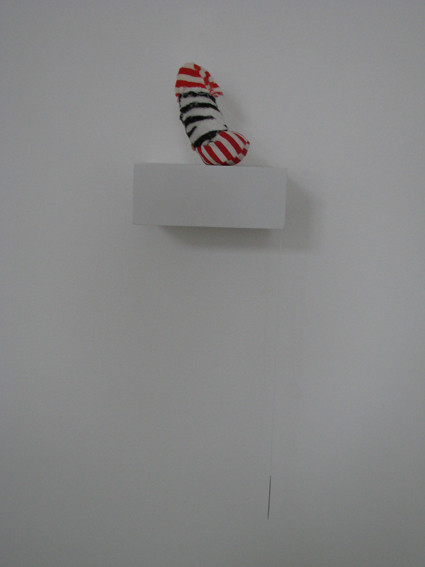Joseph Havel
28 Oct 2008 - 17 Jan 2009
JOSEPH HAVEL
"Devil’s Cloth & Daniel Buren"
Devil’s Cloth & Daniel Buren is a play on a short story by Stephen Vincent Benet called “the Devil and Daniel Webster” which reinforces the association to the American flag in a oblique way. When striped clothing was first introduced into western European culture, specifically in France at the end of the crusades when the Carmelite Monks arrived, it was perceived as the visual equivalent of speaking in tongues or demonic speech because it subverted the figure ground relationship so was pictorially illegible. This is actually the roots of it association with the outsider, the criminal, and the subversive. This subversive root leads us to the use of stripes in revolutionary images such as the early French and American flags as well as its use by pivotal modern and contemporary artist such as Daniel Buren and Agnes Martin where it subverts accepted pictorial hierarchies. Picasso’s interest in dressing in stripes or having pant’s “to stripe the ass” as he quoted as saying in the footnotes to The Devil’s Cloth exemplifies how striped clothing demarks both the criminal and the rogue.
This new body of work is really a continuation of my earlier investigations on how images and motifs that are accepted as part of the everyday are rooted in a social history that often is linked to class authority and power. My early works focused on white shirts and the color white with a similar interest in stripping the image of he commonly accepted of neutrality.
"Devil’s Cloth & Daniel Buren"
Devil’s Cloth & Daniel Buren is a play on a short story by Stephen Vincent Benet called “the Devil and Daniel Webster” which reinforces the association to the American flag in a oblique way. When striped clothing was first introduced into western European culture, specifically in France at the end of the crusades when the Carmelite Monks arrived, it was perceived as the visual equivalent of speaking in tongues or demonic speech because it subverted the figure ground relationship so was pictorially illegible. This is actually the roots of it association with the outsider, the criminal, and the subversive. This subversive root leads us to the use of stripes in revolutionary images such as the early French and American flags as well as its use by pivotal modern and contemporary artist such as Daniel Buren and Agnes Martin where it subverts accepted pictorial hierarchies. Picasso’s interest in dressing in stripes or having pant’s “to stripe the ass” as he quoted as saying in the footnotes to The Devil’s Cloth exemplifies how striped clothing demarks both the criminal and the rogue.
This new body of work is really a continuation of my earlier investigations on how images and motifs that are accepted as part of the everyday are rooted in a social history that often is linked to class authority and power. My early works focused on white shirts and the color white with a similar interest in stripping the image of he commonly accepted of neutrality.

